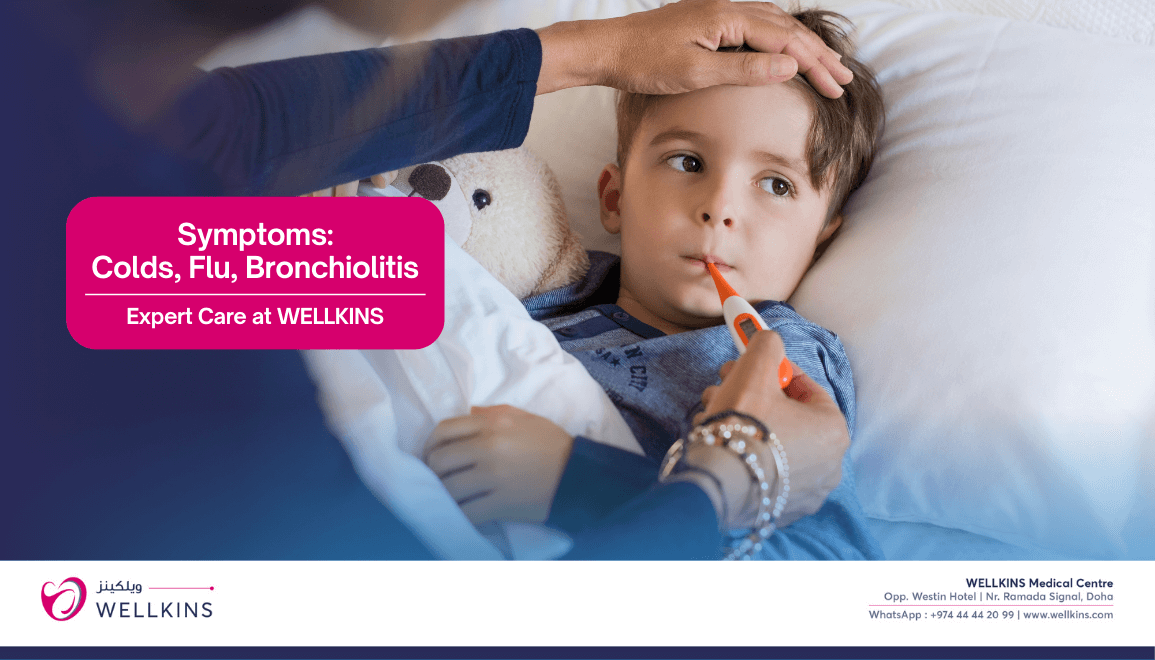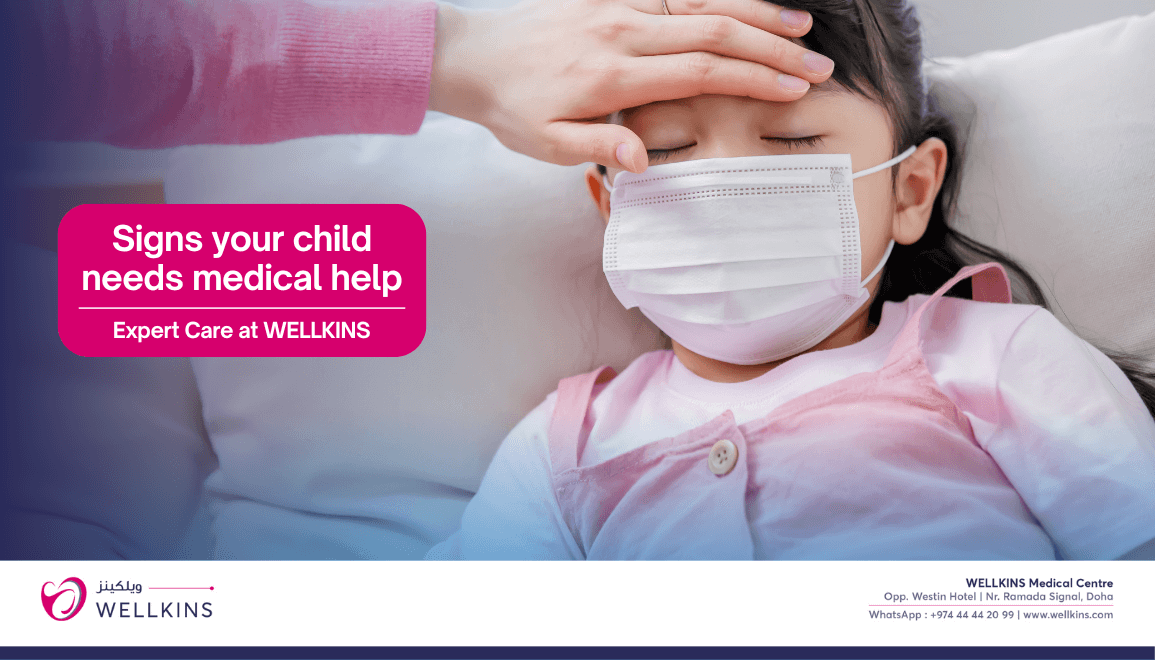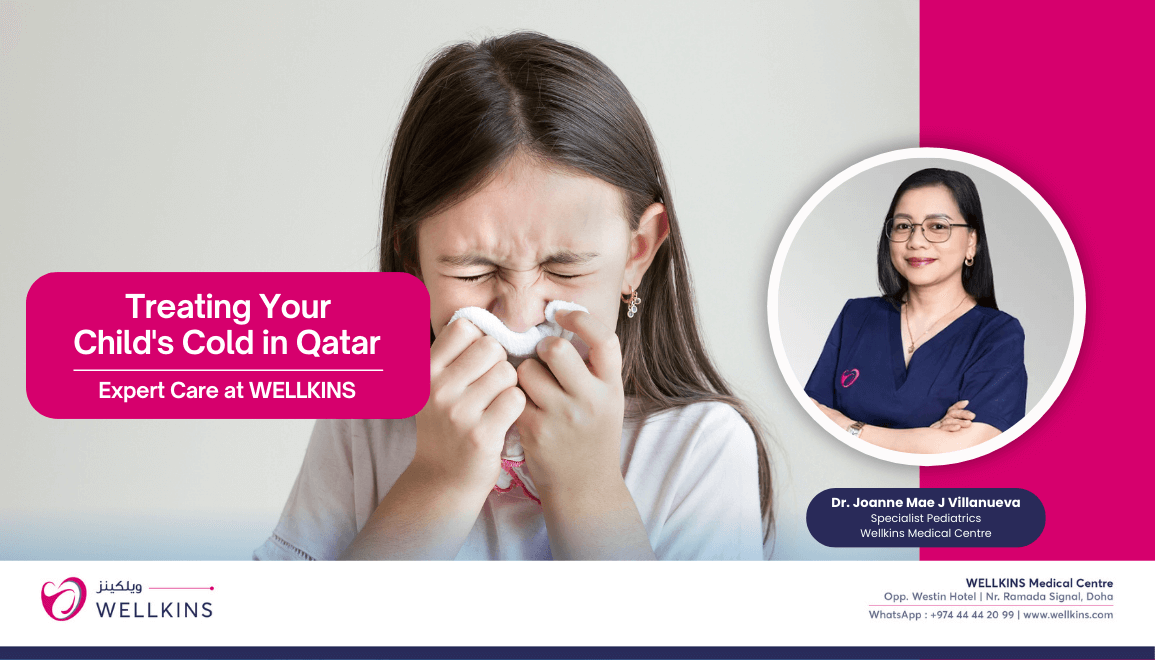Author: Dr. Joanne Mae J Villanueva, Specialist Pediatrics Wellkins Medical Centre
As a parent, there are few things more concerning than a sick child. The sound of a persistent cough, the sight of a runny nose, and the feel of a fever can send even the most experienced parent into a spiral of worry. In Qatar, as seasons change and children spend more time in close quarters at school or daycare, it’s common to see a rise in childhood infections. While most are mild and resolve on their own, understanding the key differences between a common cold, the flu, and a more serious condition like bronchiolitis is crucial for your child’s well-being. Knowing when to simply provide comfort and when to seek medical help can make all the difference.
Every parent knows that a sick child can turn your world upside down. The sound of a persistent cough, the sight of a runny nose, and the feel of a fever are instantly concerning. With seasons changing and children gathering in schools and daycares across Qatar, it’s common to see a rise in childhood illnesses.
Decoding the Symptoms: Colds vs. Flu vs. Bronchiolitis
While these conditions share some overlapping symptoms, they affect children differently and require varying levels of attention.

The Common Cold
The most frequent of all childhood illnesses, colds are caused by viruses and are generally mild. The symptoms of a Cold:
- Runny or stuffy nose (mucus may start clear and become thicker and yellowish).
- Sneezing.
- Mild cough.
- Sore throat.
- Low-grade fever (more common in younger children).
The Flu (Influenza)
More severe than a cold, the flu is a viral respiratory illness that often comes on suddenly and can lead to more serious complications. The symptoms of a flu are:
- Sudden onset of high fever (often above 38°C).
- Body aches and chills.
- Headache.
- Significant fatigue and exhaustion.
- Dry, hacking cough.
- Sore throat and runny nose.
- Vomiting or diarrhea (more common in children than adults).
The Bronchiolitis
This is a viral infection that causes inflammation and blockage of the small airways (bronchioles) in the lungs. It is most common in infants and young children, especially during the cooler months, and is often caused by the Respiratory Syncytial Virus (RSV). The Symptoms of Bronchiolitis are:
- Starts with mild cold-like symptoms (runny nose, cough).
- Develops into more serious signs of breathing difficulty, such as:
- Wheezing or noisy breathing.
- Rapid and shallow breathing.
- Chest retractions (sucking in of the skin around the ribs or collarbone with each breath).
- Difficulty feeding due to breathing problems.

Signs Your Child Needs Medical Help
Most colds can be managed at home with rest and fluids. However, it is essential to contact a pediatrician if your child’s symptoms are severe or if you notice any of the following:
- High fever: A fever of 38°C or higher in a baby under 3 months old, or a fever of 39°C or
higher in an older child, especially if it doesn’t improve with medication. - Difficulty breathing: Any signs of rapid or labored breathing, grunting, wheezing, or chest retractions are a medical emergency.
- Dehydration: Signs include a dry mouth, no tears when crying, and urinating less frequently.
- Severe or worsening symptoms: If your child’s symptoms seem to get better but then return or worsen, or if they are unusually irritable, lethargic, or unresponsive.
- Persistent cough: A cough that lasts for several weeks.
A Proactive Approach to Health: Easing Symptoms and Preventing Illness
While you can’t prevent every infection, you can take steps to manage symptoms and strengthen your child’s immune system.
- Encourage Rest: Allow your child to rest as much as possible to help their body fight the infection.
- Stay Hydrated: Offer plenty of fluids like water, diluted juice, or clear broths. This is especially important if they have a fever or are vomiting.
- Use Saline Drops or Spray: For a stuffy nose, saline drops can help loosen mucus and make it easier for your child to breathe.
- Humidifier: A cool-mist humidifier in your child’s room can help soothe a dry cough and a stuffy nose.
- Pain and Fever Relief: Use age-appropriate doses of acetaminophen or ibuprofen as directed by your doctor to manage fever and discomfort. Always consult a doctor before giving any medication to an infant.
- Prioritize Immunizations: Ensure your child is up-to-date on all routine vaccinations, including the annual flu vaccine, as it is the most effective way to prevent influenza and its complications.

Addressing your child’s illness can feel overwhelming, but you don’t have to navigate it alone. At Wellkins Medical Centre we are here to support you with personalized advice and compassionate care.
We focus on providing accurate diagnoses and creating personalized treatment plans that address your child’s unique needs. From managing common infections and answering your questions to providing well-child checkups and immunizations, we are dedicated to helping your little one stay healthy.
To book an appointment at Wellkins Medical Centre: https://wellkins.com/visit






